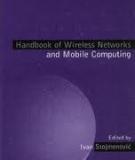Tài liệu Thư viện số
- Công nghệ thông tin (2019 )
- Điện tử viễn thông (1133 )
- Quản trị kinh doanh (1305 )
- Kế toán (1003 )
- Môi trường (968 )
- Du lịch (861 )
- Kiến trúc (424 )
- Xây dựng (1082 )
- Ngoại ngữ (302 )
- Y dược (1391 )
- Khoa học tự nhiên (874 )
- Khoa học xã hội (514 )
- Lý luận chính trị (573 )
- Sau đại học (243 )
- Tài liệu tham khảo khác (252 )
Danh mục TaiLieu.VN
- Mẫu Slide Powerpoint
- Luận Văn - Báo Cáo (344720)
- Kinh Doanh Marketing (65512)
- Kinh Tế - Quản Lý (48934)
- Tài Chính - Ngân Hàng (55898)
- Công Nghệ Thông Tin (142209)
- Tiếng Anh - Ngoại Ngữ (47066)
- Kỹ Thuật - Công Nghệ (134345)
- Khoa Học Tự Nhiên (107174)
- Khoa Học Xã Hội (82451)
- Văn Hoá - Nghệ Thuật (54408)
- Y Tế - Sức Khoẻ (173915)
- Nông - Lâm - Ngư (62504)
- Kỹ Năng Mềm (29016)
- Biểu Mẫu - Văn Bản (27610)
- Giải Trí - Thư Giãn (51994)
- Văn Bản Luật (198854)
- Tài Liệu Phổ Thông (402015)
- Trắc Nghiệm Online (213578)
- Trắc Nghiệm MBTI
- Trắc Nghiệm Holland
Handbook of Wireless Networks and Mobile Computing
The past five decades have witnessed startling advances in computing and communication technologies that were stimulated by the availability of faster, more reliable, and cheaper electronic components. The design of smaller and more powerful devices enabled their mobility, which is rapidly changing the way we compute and communicate.
For instance, the worldwide number of cellular phone subscribers has quadrupled in the last five years and has grown to over half a billion (see www.gsmdata.com). Wireless and mobile networks are emerging as networks of choice, due to the flexibility and freedom they offer. The use of satellite, cellular, radio, sensor, and ad hoc wireless networks, wireless local area networks (LAN), small portable computers, and personal communication systems (PCS) is increasing. These networks and devices support a trend toward computing on the move, known as mobile computing, nomadic computing, or computing anywhere anytime. The applications of mobile computing and wireless networks include e-commerce, personal communications, telecommunications, monitoring remote or dangerous environments, national defense (monitoring troop movements), emergency and disaster operations, remote operations of appliances, and wireless Internet access.
For instance, the worldwide number of cellular phone subscribers has quadrupled in the last five years and has grown to over half a billion (see www.gsmdata.com). Wireless and mobile networks are emerging as networks of choice, due to the flexibility and freedom they offer. The use of satellite, cellular, radio, sensor, and ad hoc wireless networks, wireless local area networks (LAN), small portable computers, and personal communication systems (PCS) is increasing. These networks and devices support a trend toward computing on the move, known as mobile computing, nomadic computing, or computing anywhere anytime. The applications of mobile computing and wireless networks include e-commerce, personal communications, telecommunications, monitoring remote or dangerous environments, national defense (monitoring troop movements), emergency and disaster operations, remote operations of appliances, and wireless Internet access.
Từ khóa: communication technologies, Wireless Networks, Mobile Computing, công nghệ truyền thông, linh kiện điện tử, kỹ thuật điện tử
648 p trinh 10/11/2012 217 1


